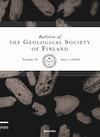芬兰西南部的萨利图组,第一部分:构造、年龄和地层学
IF 1.3
4区 地球科学
Q2 GEOLOGY
引用次数: 4
摘要
由于火山和火山碎屑岩的变质等级相对较低,应变较低,早期构造保存较好,Orijärvi三角(位于较大的Orijärvi地区的中心)是芬兰南部斯韦芬尼造山带中为数不多的确定岩石地层学的地点之一。位于Orijärvi地区东北部的Salittu组苦海玄武质变质火山岩的地球化学特征已经确定,但基岩和构造几乎没有被触及。通过重新测图,我们给出了构造演化的解释,提供了新的时代数据来约束萨里图火山活动的持续时间,并完善了Orijärvi地区的地层。在萨里图可以看到原始的地层:变质玄武岩覆盖在混染片麻岩上,变质长石在上面。在早期的s1 - d2期变形过程中,岩石褶皱发育,在后期的D2-D5期变形过程中形成了大型的干涉构造。Salittu的构造模式与Orijärvi三角的构造模式大致相同。新的年龄数据,结合先前发表的数据,限制了大约1875 Ma的萨利图火山活动。Orijärvi地区地层为早期(1.90 ~ 1.89 Ga)火山Orijärvi组,上覆沉积Vetio组、火山Kisko组、火山-沉积Ahdisto组、火山Toija组,上覆Salittu组,侵位在1.88 ~ 1.87 Ga。我们提出了一个模型,其中Orijärvi组代表了微大陆边缘的岩浆活动,而上覆的包体代表了微大陆初始增生阶段俯冲带上方的沉积和岩浆活动。D1变形发生在沙里图组火山岩侵位后的增生晚期。本文章由计算机程序翻译,如有差异,请以英文原文为准。
The Salittu Formation in southwestern Finland, part I: Structure, age and stratigraphy
Because of the relatively low metamorphic grade, low strain and well-preserved early structures in volcanic and volcaniclastic rocks, the Orijärvi triangle (in the center of the larger Orijärvi area) is one of the few locations in the Svecofennian orogen of southern Finland where lithostratigraphy has been determined. The geochemistry of the picriticbasaltic metavolcanic rocks of the Salittu Formation, located in the northeastern part of the Orijärvi area, has been characterized but otherwise the bedrock and structures have been barely touched. After remapping we give an interpretation of structural evolution, provide new age data to constrain duration of volcanism at Salittu, and refine the stratigraphy in the Orijärvi area. The original stratigraphy is visible at Salittu: metabasalt overlies migmatitic gneisses, and metapicrite is on top. The rocks were folded during early Svecofennian D1–D2 deformations, and the large synformal structures developed as D2–D5 interference structures formed during late Svecofennian D5 deformation. The structural pattern at Salittu is much the same as in the Orijärvi triangle. The new age data, combined with earlier published data, constrains the Salittu volcanism at ca. 1875 Ma. The stratigraphy in the Orijärvi area consists of the early (1.90–1.89 Ga) volcanic Orijärvi Formation, overlain by the sedimentary Vetio Formation, the volcanic Kisko Formation, the volcanic-sedimentary Ahdisto Formation, the volcanic Toija Formation, and on top the Salittu Formation, all emplaced at 1.88–1.87 Ga. We propose a model in which the Orijärvi Formation represents magmatism at the margin of a microcontinent, and the overlying package represents sedimentation and magmatism above a subduction zone during an initial stage of microcontinental accretion. D1 deformation occurred in an advanced stage of accretion, after emplacement of the volcanic rocks of the Salittu Formation.
求助全文
通过发布文献求助,成功后即可免费获取论文全文。
去求助
来源期刊
CiteScore
1.30
自引率
0.00%
发文量
5
审稿时长
>12 weeks
期刊介绍:
Bulletin of the Geological Society of Finland (BGSF) publishes research articles and short communications in all branches of geosciences. Contributions from outside Finland are welcome, provided that they contain material relevant to Finnish geology or are of general interest.

 求助内容:
求助内容: 应助结果提醒方式:
应助结果提醒方式:


